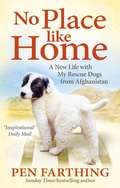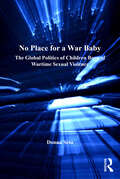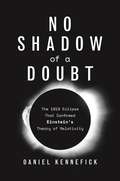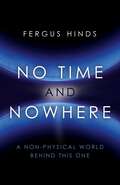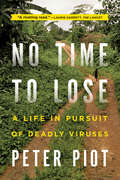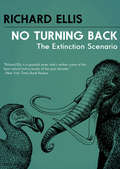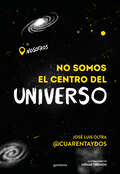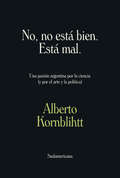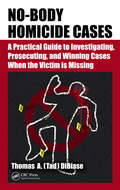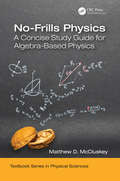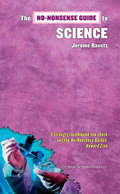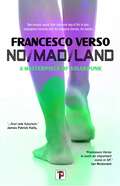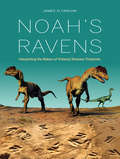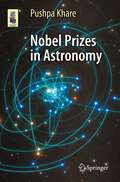- Table View
- List View
No Place Like Home: A New Beginning with the Dogs of Afghanistan
by Pen FarthingMarley and Me meets Bravo Two Zero, in this sequel to One Dog at a Time: Saving the Strays of Afghanistan. Nowzad was a gentle giant when it came to taking treats. He never, ever snatched. To me it was just further evidence that, deep inside, there was a great dog struggling to find his way out. When Pen Farthing brings stray dogs Nowzad and Tali back from his tour of Afghanistan, little does he know what he has begun. Suddenly he has four dogs to look after—two of whom have never been housetrained. And soon he is inundated with requests from other Marines and soldiers to help bring their rescued dogs home. Whether it's little Helmand, Fubar, or Beardog, Pen does his utmost to give these dogs the chance they deserve. This is the story of one man's courage and persistence as he struggles to give his dogs at home, and those still in Afghanistan, the best possible chance. It will warm—and break—the hearts of dog lovers everywhere.
No Place for a War Baby: The Global Politics of Children born of Wartime Sexual Violence (Gender in a Global/Local World)
by Donna SetoDonna Seto investigates why children born of wartime sexual violence are rarely included in post-conflict processes of reconciliation and recovery. The focus on children born of wartime sexual violence questions the framework of understanding war and recognizes that certain individuals are often forgotten or neglected. This book considers how children are neglected sites for the reproduction of global norms. It approaches this topic through an interdisciplinary perspective that questions how silence surrounding the issue of wartime sexual violence has prevented justice for children born of war from being achieved. In considering this, Seto examines how the theories and practices of mainstream International Relations (IR) can silence the experiences of war rape survivors and children born of wartime sexual violence and explores the theoretical frameworks within IR and the institutional structures that uphold protection regimes for children and women.
No Shadow of a Doubt: The 1919 Eclipse That Confirmed Einstein's Theory of Relativity
by Daniel J KennefickOn their 100th anniversary, the story of the extraordinary scientific expeditions that ushered in the era of relativityIn 1919, British scientists led extraordinary expeditions to Brazil and Africa to test Albert Einstein’s revolutionary new theory of general relativity in what became the century’s most celebrated scientific experiment. The result ushered in a new era and made Einstein a global celebrity by confirming his dramatic prediction that the path of light rays would be bent by gravity. Today, Einstein’s theory is scientific fact. Yet the effort to “weigh light” by measuring the gravitational deflection of starlight during the May 29, 1919, solar eclipse has become clouded by myth and skepticism. Could Arthur Eddington and Frank Dyson have gotten the results they claimed? Did the pacifist Eddington falsify evidence to foster peace after a horrific war by validating the theory of a German antiwar campaigner? In No Shadow of a Doubt, Daniel Kennefick provides definitive answers by offering the most comprehensive and authoritative account of how expedition scientists overcame war, bad weather, and equipment problems to make the experiment a triumphant success.The reader follows Eddington on his voyage to Africa through his letters home, and delves with Dyson into how the complex experiment was accomplished, through his notes. Other characters include Howard Grubb, the brilliant Irishman who made the instruments; William Campbell, the American astronomer who confirmed the result; and Erwin Findlay-Freundlich, the German whose attempts to perform the test in Crimea were foiled by clouds and his arrest.By chronicling the expeditions and their enormous impact in greater detail than ever before, No Shadow of a Doubt reveals a story that is even richer and more exciting than previously known.
No Stone Unturned: The True Story of the World's Premier Forensic Investigators
by Steve JacksonThe New York Times bestselling author takes readers on &“a fascinating journey into the trenches of crime [investigation]&”—now revised and updated (Lowell Cauffiel, New York Times bestselling author).A body stuffed in a car trunk swallowed by the swirling, muddy waters of the Missouri River. A hiker brutally murdered, then thrown off a steep embankment in a remote mountain range. A devious killer who hid his wife&’s body under a thick cement patio. For investigators, the story is often the same: they know a murder took place, they may even know who did it; but without key evidence, or a body, pursuing a conviction is nearly impossible. That&’s when they call NecroSearch International, a brain trust of the nation&’s top scientists in a wide variety of fields, who along with law enforcement, use the latest technology and field techniques to locate clandestine graves and hidden secrets to solve &“unsolvable&” crimes. In No Stone Unturned, Steve Jackson—who became a member of NecroSearch International in 2015—gives a captivating, insider&’s look into a realm of crime investigation of which few people are aware. &“The book covers the group&’s quirky beginnings and digs into its most important cases suspensefully; Jackson&’s sharp eye misses nothing in the painstakingly rendered details. A must-have for true crime fans, it should also be of great interest to anyone fascinated with the practical applications of science.&”—Publishers Weekly (starred review)&“Delves into cases that would make good novels, but they&’re real. Furthermore, he describes a group of uncommon people performing uncommon tasks, and he does it with respect, accuracy and genuine style.&”—Ron Franscell, bestselling author of Alice & Gerald: A Homicidal Love Story
No Time and Nowhere: A Non-Physical World Behind this One
by Fergus HindsWhy do so many people believe in an Invisible World behind this one? Scientists a parallel universe? Religions an afterlife? Others &‘just something'? Perhaps for observations we cannot explain? Some are psychological, e.g. the nature, storage, and conveyance of the information implicit in 'ghosts', hunches, premonitions and hypnosis; and some are material – the behaviour of particles on a very small scale in physics laboratories. Each hints at spatial or temporal derangement. Space and Time are the indivisible foundations of physics. Everything that exists has a location and duration; physics concerns nothing without both. We can suppose the universe bound not by a physical framework of space-time but as containing within itself all Space and all Time - with a little more besides. Another world is not a baseless idea.
No Time to Lose: A Life in Pursuit of Deadly Viruses
by Peter PiotAs a young scientist, Peter Piot named a newly discovered virus "ebola." This is the story of his extraordinary career. When Peter Piot was in medical school, a professor warned, "There's no future in infectious diseases. They've all been solved." Fortunately, Piot ignored him, and the result has been an exceptional, adventure-filled career. In the 1970s, as a young man, Piot was sent to Central Africa as part of a team tasked with identifying a grisly new virus. Crossing into the quarantine zone on the most dangerous missions, he studied local customs to determine how this disease--the Ebola virus--was spreading. Later, Piot found himself in the field again when another mysterious epidemic broke out: AIDS. He traveled throughout Africa, leading the first international AIDS initiatives there. Then, as founder and director of UNAIDS, he negotiated policies with leaders from Fidel Castro to Thabo Mbeki and helped turn the tide of the epidemic. Candid and engrossing, No Time to Lose captures the urgency and excitement of being on the front lines in the fight against today's deadliest diseases.
No Turning Back
by Richard EllisConservationist Richard Ellis's fascinating examination of extinction, "one of the most powerful forces on earth, and one of the most enigmatic" In No Turning Back, naturalist Richard Ellis conducts a masterful and engrossing investigation of one of the world's most harrowing inevitabilities: extinction. Taking a concentrated look at a variety of species--from those that went out with a bang upon the impact of an Everest-sized asteroid to those that gradually disappeared after years of human overhunting--Ellis discusses the five great mass extinctions in history, and how extinction shapes the evolutionary process. He also outlines the steps we can take to ensure that today's endangered species can be pulled back from the brink. Richly illustrated with Ellis's stunning, hand-drawn artwork, No Turning Back is an invaluable read for anyone seeking to understand the past, present, and future of life on our planet.
No Way . . . Way!: Stinky, Sticky, Sneaky Stuff (Smithsonian)
by Tracey WestA must-have for readers of Smithsonian's No Way . . .Way! Road Trip and No Way . . .Way! Are You My Dinner?A stinky plant that smells like a corpse? A forklift suspended by sticky glue? Sneaky robbers dressed as cops? No way! But way! It's all true and all fun to read about in this snappy book of cool facts and photos from across the Smithsonian's vast collections.
No Wonder You Wonder!
by Claude PhippsThis book explores and explains scientific mysteries and principles, leavened with tongue-in-cheek humor and an abundance of illustrations. Chapters are short, but give an understanding of technology and science not available elsewhere. Questions include: * What holds a satellite up while it goes around the Earth? * Why is the sky (made out of clear air!) blue instead of green, or just black as night like the sky that high altitude jumper Felix Baumgartner saw? * How is laser light different from "normal" light? * Did Columbus really discover that the Earth is round? * Which one invention will assuredly survive our civilization? * Why can't you travel back in time? If you often feel embarrassed because you don't have a clue about lasers, the difference between volts, amps and watts, or how jet planes really work - but you would like to understand the physical principles of our modern world, whether you're a teen or a parent - this book is for you! To understand the basics of quantum mechanics, or of protons, neutrons and electrons, you don't need algebra, calculus,or a lot of equations or technical buzzwords. Too many people have been soured on science by science teachers who have made simple concepts seem complex. This book is the antidote: all it requires is your curiosity. Advance praise for No Wonder You Wonder!: "From beginning to end, and with laugh after laugh, I enjoyed every single word of this remarkable book. Phipps is a hell of a good writer, and the kind of physics teacher that I would have loved as a young student. No Wonder You Wonder can be engrossing for anyone with a bit of curiosity, not just the scientific minded. " - Christophe Bonnal, Chief Engineer, CNES (French Space Agency) "No Wonder You Wonder is a fa ntastic book. Covering topics such as space, matter, and the energy within the universe, this book does an excellent job of clarifying these topics. It's a great read for young scientists and aspiring physicists. " - August R. , high school freshman
No es un monstruo
by Claudia Guadalupe Martinez¡AHORA ES ESPAÑOL! Con un concepto de color ingenioso, este poético libro ilustrado muestra el ciclo de vida del amado anfibio, el ajolote, en su hábitat natural.NOW IN SPANISH! With a clever color concept, this poetic picture book shares the life cycle of beloved amphibian—the axolotl—in its natural habitat.Un ajolote pudiera parecerlo, pero definitivamente No es un monstruo. Esta curiosa criatura, popularizada por Minecraft, es en realidad una salamandra que nunca perderá sus branquias o aletas. No es un monstruo explora las características del ajolote, el origen mítico de los aztecas sobre la especie y el modo en que la contaminación afecta su hábitat natural: los canales de Xochimilco en la Ciudad de México.Divertido y cautivador, este libro juguetón e informativo presenta a sus lectores curiosos un personaje fantástico que... ¡NO es un monstruo!An axolotl may look like one, but it is certainly Not a Monster. This curious creature, made popular by Minecraft, is actually a salamander that will never lose its gills or fins. Not a Monster explores the traits of the axolotl, the Aztec origin myth about the species, and the way pollution is affecting its natural habitat: the canals of Xochimilco in Mexico City. Fun and engaging, this playful and informative read-aloud introduces curious readers on one cool character who is NOT a monster!
No fungi no future: Wie Pilze Die Welt Retten Können
by Jan I. LelleyDas Buch für naturwissenschaftlich interessierte Leser, die sich Gedanken machen über die anstehenden Probleme einer zahlenmäßig rasch zunehmenden Weltbevölkerung. Das Buch klärt über den bisher allgemein kaum bekannten Nutzen der sogenannten Großpilze auf. Es sind Pilze, die man sonst von Spaziergängen in Wald und Wiese kennt und die man im Handel kaufen kann. Wie können Großpilze dazu beitragen die Menschheit zu retten?Können Ernährungsprobleme in armen Ländern Afrikas durch Großpilze gelöst werden?Gelingt eine Revitalisierung ganzer geschädigter Wälder?Und was haben Pilze auf dem Mars zu suchen?Diese und weitere spannende Fragen werden im Verlauf der Kapitel beantwortet. Die Leser bekommen Einblicke in die Geheimnisse und Arbeitsweisen einer Wissenschaft, die, wie auch Pilze, im Verborgenen aktiv ist, deren Bedeutung rapide steigt, obwohl sie bisher nur von relativ wenigen Forschern betrieben wird.
No seas neandertal: y otras historias sobre la evolución humana
by Sang-Hee Lee Shin-Young YoonEn este fascinante best seller internacional, la paleoantropóloga coreana Sang-Hee Lee explora y cuestiona algunas de las asunciones evolutivas más importantes con resultados del todo inesperados. ¿Qué información pueden darnos unos dientes fosilizados sobre la esperanza de vida de nuestros ancestros? ¿Fue la agricultura un paso en falso en la evolución humana? ¿Cómo pueden unas simples comparaciones geométricas de cráneos y fósiles pélvicos sugerir un posible origen de nuestra naturaleza social? ¿Qué tenemos realmente en común con los neandertales? A través de una serie de jugosos capítulos, este libro nos ofrece nuevas perspectivas sobre nuestros primeros antepasados homínidos, desafiando las percepciones sobre la progresión tradicional de la evolución. Al combinar una visión antropológica con una investigación vanguardista e innovadora, las sorprendentes conclusiones de Lee arrojan nueva luz sobre los comienzos de la humanidad y nos conectan con nuestro pasado más remoto. No seas neandertal es el libro perfecto para todos aquellos curiosos que quieren otra historia sobre nuestros orígenes y todo el proceso que nos ha traído hasta aquí. A medida que avanzamos en el camino evolutivo, Lee nos ayuda a determinar hacia dónde nos dirigimos y aborda una de nuestras preguntas científicas más apremiantes: ¿sigue evolucionando la humanidad?
No somos el centro del universo: Un libro lleno de humor para descubrir los misterios más fascinantes y mejor guardados del universo
by José Luis Oltra @cuarentaydosUn libro lleno de humor para descubrir los misterios más fascinantes y mejor guardados del UNIVERSO. Desde la existencia del propio mundo los avances y descubrimientos científicos han sido el motor del progreso de la humanidad. Pero nuestras creencias no han sido siempre las mismas y hoy en día sigue habiendo un montón de dudas que nos asaltan: ¿acaso somos tan especiales como nos creemos?, ¿se puede apagar el Sol? ¿abandonaremos algún día la Tierra?, ¿es posible habitar otros planetas?, ¿hay vida inteligente ahí fuera?, ¿qué es eso de la materia oscura? Un recorrido desternillante por la historia del universo para entender de dónde venimos, pero, sobre todo, a dónde vamos.
No, no está bien. Está mal: Una pasión argentina por la ciencia (y por el arte y la política)
by Alberto KornblihttTestimonio absolutamente personal del científico argentino más reconocido en el mundo que da cuenta de su pasión por la investigación, pero también de su amor por el cine, la literatura y la música, sus obsesiones personales, su historia, su participación en la esfera pública y su reivindicación de la política. Alberto Kornblihtt le dijo "No, no está bien. Está mal" a la senadora Silvia Elías de Pérez, en el marco de las audiencias públicas previas al debate en el Congreso de la Nación de la ahora ley 27.610 de acceso a la interrupción voluntaria del embarazo. Antes de que terminara su exposición esa frase se había viralizado en las redes sociales: la oposición entre conocimiento y charlatanismo se convertía en "meme". Pero ¿quién era ese profesor universitario que con información científica y razonamiento lógico mientras expresaba su apoyo a un proyecto restituía algo de valor a la argumentación y al saber en tiempos de eslóganes y perogrulladas? Este libro absolutamente personal responde esa pregunta; presenta a uno de los científicos argentinos con más prestigio en el mundo en su faceta más humana (y, por qué no, humanista). Aquí aparecen, en primera persona, el Kornblihtt apasionado por la literatura, la música y el cine; el que se permite exponer su subjetividad y contar su historia personal y familiar; el que ejerce ciudadanía a través de sus intervenciones en la esfera pública y su reivindicación de la política y, sobre todo, el que da testimonio con su propia vida del valor social de la reflexión y el pensamiento críticos.
No-Body Homicide Cases: A Practical Guide to Investigating, Prosecuting, and Winning Cases When the Victim Is Missing
by Thomas A.(Tad) DiBiaseA practical guide for police, death investigators, and prosecutors, No-Body Homicide Cases: A Practical Guide to Investigating, Prosecuting, and Winning Cases When the Victim is Missing, Second Edition takes an expansive look at both the history of no-body murder cases and the best methods to investigate, solve, and bring them to court. How do you prove someone guilty of murder when the best and primary piece of evidence—the victim’s body—is missing? Exclusively dedicated to the investigation and prosecution of no-body homicide cases, this fully updated Second Edition provides the author’s insight gained from investigating, consulting on, and trying scores of no-body cases throughout the United States. Taking readers step-by-step from the first days of a homicide investigation through the trial, the book explores the history of confessions and discloses the investigative techniques police must use to catch these cunning killers. Chapters review methods criminals have used to dispose of bodies, delving into the psychological profile of the type of defendant who murders someone, then hides the body. Since the last edition published, the number of no-body murder cases investigated has skyrocketed, with more than 50 percent of all no-body murder cases tried and prosecuted have occurred since the year 2000. New to this edition is a chapter on a full, singular high-profile case from start to finish, to illustrate the entire no-body investigative and adjudication process. A sample arrent warrant for a no-body murder case is provided in addition to Chapter 12 updating the prior edition’s nearly 400 case summaries provided to the current figure, as of this publication, of 576 no-body murder trials in U.S. history. No-Body Homicide Cases, Second Edition continues to serve as an essential resource and the "how-to" manual for investigating, prosecuting, and winning no-body murder cases.
No-Body Homicide Cases: A Practical Guide to Investigating, Prosecuting, and Winning Cases When the Victim Is Missing
by Thomas A.(Tad) DiBiaseHow do you prove someone guilty of murder when the best piece of evidence the victim‘s body is missing? Exclusively dedicated to the investigation and prosecution of no-body homicide cases, this book provides the author‘s insight gained from investigating and trying a no-body case along with what he‘s learned consulting on scores of others across t
No-Body Homicides: The Evolution of Investigation and Prosecution
by Mark StobbeNo-Body Homicides: The Evolution of Investigation and Prosecution examines how police and prosecutors have become more successful in obtaining convictions for homicide when the remains of the victim are unavailable as evidence. Based on an examination of over 600 cases in the United States and Canada, this book shows the length some killers will go to avoid punishment and the determination of police and prosecutors to bring them to justice. For over 300 years, murderers in the United States and Canada could avoid prosecution by successfully disposing of the body of their victim. No-Body Homicides provides the reader with a historical overview of prosecutions in which a killer destroyed or hid the body of the victim. It explains why prosecutions were once extremely rare, and how legal, attitudinal, and technical changes have made them more common. The book also explores how the logic of no-body homicide prosecutions differs from body-present homicides. It allows police and prosecutors to draw on the accumulated experience of hundreds of prosecutions. For criminology students, it provides fascinating insights into the process of investigating and prosecuting homicides – as well as a glimpse into the motivations and practices of killers who are so determined to avoid punishment that they remove the bodies of their victims. No-Body Homicides will be of practical interest to police or prosecutors confronted with a missing person’s case that could be sinister. It is also written to be appropriate as a supplementary text in an undergraduate criminology class or for an aficionado of “True Crime.”
No-Frills Physics: A Concise Study Guide for Algebra-Based Physics (Textbook Series in Physical Sciences)
by Matthew McCluskeyThis textbook provides everything you need to get through a basic physics course. It guides students through all the essentials with a concise review of the concept, simple illustrations to demonstrate it, worked problems to showcase how to apply it, and a short quiz for self-testing. Whereas other standard books can be overwhelming to students, the author shares what has worked with his own students, trimming back unnecessary detail and focusing on the core basic physical concepts required to gain solid footing. The full range of topics are addressed in a manner that facilitates understanding and will encourage students to continue forward with their learning.
No-Nonsense Guide to Science (No-Nonsense Guides #21)
by Jerome RavetzScience is still the great intellectual adventure, but now it is also seen as an instrument of profit, power, and privilege. Wrongly used, it might yet make the 21st century our last.To make sense of all this, we need to let go of old ideas and assumptions. In the No-Nonsense Guide to Science, Jerome Ravetz introduces the “post-normal” way of thinking about science. We are to transcend the old simplistic ideas of perfect certainty and objectivity in science–they have failed to protect people and the environment when science has gone wrong and they have enabled flat, dogmatic teaching in our schools. We must now accept that value-loading, uncertainty, and ignorance are very real parts of science, and that citizens must participate in the policies that shape its evolution. The book also includes a refreshing new look at the history of science, and concludes with a series of questions that anyone can use to start their own exploration of the present and future of science.
No-till Farming Systems for Sustainable Agriculture: Challenges and Opportunities
by Yash P. Dang Ram C. Dalal Neal W. MenziesThis book is a comprehensive summary of current global research on no-till farming, and its benefits and challenges from various agronomic, environmental, social and economic perspectives. It details the characteristics and future requirements of no-till farming systems across different geographic and climatic regions, and outlines what is needed to increase the uptake of no-till farming globally. Over 35 chapters, this book covers in detail the agronomic and soil management issues that must be resolved to ensure the successful implementation of these systems. Important economic, environmental, social and policy considerations are discussed. It also features a series of case studies across a number of regions globally, highlighting the challenges and opportunities for no-till and how these may vary depending on climate and geopolitical location. This book is a remarkable compilation by experts in no-till farming systems. The promotion and expansion of no-till farming systems worldwide will be critical for food security, and resource and environmental sustainability. This is an invaluable reference for both researchers and practitioners grappling with the challenges of feeding the world’s rising population in an environment increasingly impacted by climate change. It is an essential reading for those seeking to understand the complexity of no-till farming systems and how best to optimise these systems in their region.
No/Mad/Land
by Francesco VersoA solarpunk masterpiece from a writer who champions a positive, inclusive and deep-thinking version of future possibilities.The Pulldogs leave Rome to embrace a new condition: leaving no trace of their passage, they shape a new challenging lifestyle: wandering around the world as neo-nomads to spread their solarpunk way of living and to engage on a never-ending mission to save endangered human cultures with nanites. But the vision of Alan and Nicolas about how the Pulldogs should live collide, and as a consequence, they split in two groups: one goes North to live in the beautiful wilderness of Siberia and Mongolia, while the other goes South to save the Dogon tribe from a possible extinction due to climate change in Central Africa. But at the end everybody - including a new generation of Pulldogs - will have to come back to Rome, where their incredible transformation started many years before. Sequel to the celebrated The Roamers.FLAME TREE PRESS is the imprint of long-standing Independent Flame Tree Publishing, dedicated to full-length original fiction in the horror and suspense, science fiction & fantasy, and crime / mystery / thriller categories. The list brings together fantastic new authors and the more established; the award winners, and exciting, original voices. Learn more about Flame Tree Press at www.flametreepress.com and connect on social media @FlameTreePress.
Noah's Fascinating World of STEAM Experiments: A Junior Scientist's Lab Notebook for Learning Scientific Method
by Sarah Habibi10 Fun STEAM Projects for Kids (Ages 8-12)#1 Bestseller in Children's Books on Chemistry and Children's Science Experiment Books“Sarah’s work as a STEAM educator is the perfect balance of creativity, fun, and science!”—Kellie Gerardi, bioastronautics researcher and space enthusiastFollow simple step-by-step instructions with Noah, your junior scientist guide, and explore STEAM experiments that are bubbly, colorful, big, and mind-blowing in this illustrated introduction to science, technology, engineering, art, and mathematics. Includes QR codes to Dr. Sarah Habibi's TikTok, so you can do the experiments alongside the author! A junior scientist’s guide to safe chemical reactions. Part illustrated fun, part STEAM workbook, Noah’s Fascinating World of STEAM Projects for Kids is the perfect addition to any kid scientist’s bookshelf. Dr. Sarah Habibi, the expert on TikTok science for kids and the brain behind the popular Science Bae videos, brings you 10 easy science experiments for kids to do right at home. Learn how to follow the scientific method by building a hypothesis, conducting a real experiment, and observing the results. Did something go wrong? That’s okay! Scientists mess up all the time—Noah and Dr. Habibi show you how to modify your experiment and try again.Inside, find 10 fun STEAM projects for kids, such as:Experiments with balloons and slime DIY Lava LampsWriting or drawing in invisible inkFamilies who enjoy fun science books and science activity books for kids—like Awesome Science Experiments for Kids, Steve Spangler's Super-Cool Science Experiments for Kids, The Future of Science is Female, or MinuteEarth Explains: How Did Whales Get So Big?—will love Noah’s Fascinating World of STEAM Projects for Kids.
Noah's Ravens: Interpreting the Makers of Tridactyl Dinosaur Footprints (Life of the Past)
by James O. FarlowHow can the tracks of dinosaurs best be interpreted and used to reconstruct them? In many Mesozoic sedimentary rock formations, fossilized footprints of bipedal, three-toed (tridactyl) dinosaurs are preserved in huge numbers, often with few or no skeletons. Such tracks sometimes provide the only clues to the former presence of dinosaurs, but their interpretation can be challenging: How different in size and shape can footprints be and yet have been made by the same kind of dinosaur? How similar can they be and yet have been made by different kinds of dinosaurs? To what extent can tridactyl dinosaur footprints serve as proxies for the biodiversity of their makers? Profusely illustrated and meticulously researched, Noah’s Ravens quantitatively explores a variety of approaches to interpreting the tracks, carefully examining within-species and across-species variability in foot and footprint shape in nonavian dinosaurs and their close living relatives. The results help decipher one of the world’s most important assemblages of fossil dinosaur tracks, found in sedimentary rocks deposited in ancient rift valleys of eastern North America. Those often beautifully preserved tracks were among the first studied by paleontologists, and they were initially interpreted as having been made by big birds—one of which was jokingly identified as Noah’s legendary raven.
Nobel Prizes in Astronomy (Astronomers' Universe)
by Pushpa KhareWritten in an accessible style, this unique book aims at describing the Nobel prize winning works in astronomy to readers who only have a background of high school physics. It gives a glimpse of the work done by those prize-winning astronomers at the forefront of research and the state-of-the-art techniques used for that, to an interested reader. There have been 11 years when Nobel prizes in physics have been given to astronomers. These award-winning works cover almost the entire subject of astronomy, starting from stellar structure all the way to cosmology. The prizes have been divided in 7 categories which are described in 7 chapters. For each prize a brief biography of the winner(s) is given first. The subject of the award is put into context and the reader is reminded of all the basic concepts needed for understanding the work before, finally, the prize-winning work is described. This enjoyable book will give the interested reader an excellent overview of the highlights and development of astronomy of the 20th and early 21st century.
Nobelpreise: Brisante Affairen, umstrittene Entscheidungen (Erlebnis Wissenschaft)
by Heinrich ZanklDer Nobelpreis ist die wichtigste Ehrung weltweit. Dass bei der Auswahl und Vergabe vielleicht nicht immer alles mit richtigen Dingen zugeht, ist nur menschlich - und dazu kann man viele interessante, witzige und prekäre Geschichten erzählen.
